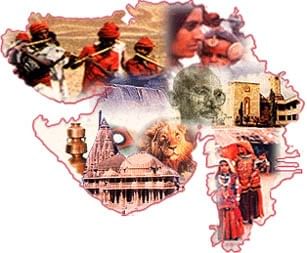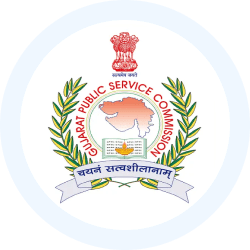GPSC (Gujarat) Exam > GPSC (Gujarat) Notes > Gujarat State PSC (GPSC) Preparation: All subjects > Administrative System of Gujarat
Administrative System of Gujarat | Gujarat State PSC (GPSC) Preparation: All subjects - GPSC (Gujarat) PDF Download
| Table of contents |

|
| Government Structure of Gujarat |

|
| Office of the Governor |

|
| State Secretariat |

|
| Divisional Commissioner |

|
| District Collector |

|
| Sub-Divisional Officer |

|
Government Structure of Gujarat
- The Government of Gujarat is a democratically elected body that administers the state. The Governor of Gujarat serves as the ceremonial head of state, while the Chief Minister, who is democratically elected, acts as the executive head.
- The Governor, appointed for a five-year term, selects the Chief Minister and the council of ministers. Although the Governor holds the nominal position, the actual governance is handled by the Chief Minister and the council of ministers, who possess significant legislative authority. The state government operates from its capital in Gandhinagar, seated at the Government Secretariat.

Office of the Governor
- The Governor holds a position in a state similar to that of the President at the national level, serving as the nominal head, while the Chief Minister acts as the executive head. Although all state executive actions are carried out in the Governor's name, their role is largely ceremonial, primarily involving the approval of decisions made by the Chief Minister and the Council of Ministers, who wield the real executive power in the state.
- An amendment to the Indian Constitution in 1956 allows the same individual to serve as the Governor of two or more states simultaneously. In addition to state governors, Lieutenant Governors are appointed for Union Territories such as Delhi, Andaman and Nicobar Islands, and Puducherry. Other Union Territories are managed by an Administrative Head, typically an IAS officer, with the exception of Chandigarh, where the Governor of Punjab also serves as the Lieutenant Governor.
State Secretariat
- The Governor and the Chief Minister hold constitutional positions, while the Chief Secretary, his secretariat, and state services are established to ensure the state government functions similarly to the Central government’s secretariat. The state secretariat is comprised of various government departments, each led politically by ministers and administratively by secretaries.
- The Chief Secretary oversees the entire state secretariat, while individual secretaries manage one or two departments. These secretaries are senior generalist administrative officers who serve the state government as a whole, rather than individual ministers. The number of secretariat departments varies between states, typically ranging from 15 to 40.
Divisional Commissioner
- In the hierarchy of supervisory area administration, the revenue administration overseen by the collector is now overseen by a divisional commissioner. A division, which serves as an administrative unit between the district and the state government, typically includes 3 to 6 districts, with the exact number varying from state to state and even within divisions in the same state.
- The commissioner, who is in charge of this division, is a senior member of the Indian Administrative Service. This position was first established in 1829 by the Bengal government as an intermediary authority between the collector and the central administration, known as commissioners of divisions.
- The practice of appointing commissioners was later extended to provinces like Punjab, Burma, Oudh, and the Central Province. Before India's independence, every province except Madras had divisional commissioners. These commissioners primarily served as revenue officials, handling appeals in revenue cases from lower authorities. The divisional commissioners have often been referred to as the "Fifth Wheel of the car" because they have minimal direct interaction with the public. This role is generally considered a promotion for senior civil service members.
Question for Administrative System of GujaratTry yourself: Which government official serves as the ceremonial head of state in Gujarat?View Solution
District Collector
- The position of District Collector was established by Warren Hastings in 1772. The primary responsibilities of the district collector included overseeing general administration, collecting land revenue, and maintaining law and order within the district. As the head of the revenue organization, the district collector was in charge of tasks such as the registration, alteration, and partition of land holdings, resolving disputes, managing indebted estates, providing loans to farmers, and handling famine relief. All other district officials were subordinate to the collector and required to keep him informed about activities in their respective departments. Additionally, the district collector also served as the District Magistrate.
- In his role as District Magistrate, he supervised the police and lower courts in the district and also carried out judicial duties. After India's independence, the judicial powers of the collector were transferred to judicial officers within the district. With the introduction of the Community Development Programme, the collector's role expanded to include the implementation of government development programs within the district.
- The District Magistrate or Collector serves as the chief executive, administrative, and revenue officer of the district, ensuring the coordination of various official agencies operating within the district.
The functions and responsibilities of the District Magistrate or Collector can be broadly categorized as:- Collector
- District Magistrate
- Deputy Commissioner
- Chief Protocol Officer
- Chief Development Officer
- Returning Officer
Sub-Divisional Officer
- A sub-division, composed of several tehsils, is managed by a Sub-Divisional Officer (SDO), who holds both administrative and judicial responsibilities. The SDO acts as a magistrate and a revenue officer, with duties similar to those of the District Collector but on a sub-divisional level.
- The SDO’s revenue duties include regulating and resolving land revenue issues, supervising revenue matters from assessment to collection, coordinating work in departments like revenue, agriculture, veterinary, and public health, and managing the appointment and dismissal of minor revenue officials. The SDO also compiles agricultural statistics and handles judicial functions such as deciding land rights cases, adjusting rents, addressing illegal subletting, and determining rightful land ownership in disputes.
Question for Administrative System of GujaratTry yourself: What are the primary responsibilities of a District Collector?View Solution
The document Administrative System of Gujarat | Gujarat State PSC (GPSC) Preparation: All subjects - GPSC (Gujarat) is a part of the GPSC (Gujarat) Course Gujarat State PSC (GPSC) Preparation: All subjects.
All you need of GPSC (Gujarat) at this link: GPSC (Gujarat)
FAQs on Administrative System of Gujarat - Gujarat State PSC (GPSC) Preparation: All subjects - GPSC (Gujarat)
| 1. What is the role of the Commissioner and District Collector in the administrative system of Gujarat? |  |
Ans. The Commissioner and District Collector in Gujarat play a crucial role in the administration of the district. They are responsible for overseeing various government functions, implementing policies, maintaining law and order, and ensuring the overall development of the district.
| 2. What is the difference between a District Magistrate and a Collector in the Indian Administration system? |  |
Ans. In the Indian Administration system, the District Magistrate is primarily responsible for law and order, while the Collector is in charge of revenue administration. However, in some states like Gujarat, both roles are often combined into one position known as the District Collector.
| 3. How does the administrative system of Gujarat function under the Gujarat Public Service Commission (GPSC)? |  |
Ans. The administrative system of Gujarat operates under the guidance and supervision of the Gujarat Public Service Commission (GPSC). The GPSC is responsible for conducting recruitment exams, selecting candidates for various administrative roles, and ensuring the efficient functioning of the state's administrative machinery.
| 4. What are some of the key responsibilities of the District Magistrate or Collector in Gujarat? |  |
Ans. Some of the key responsibilities of the District Magistrate or Collector in Gujarat include maintaining law and order, overseeing revenue administration, implementing government policies, coordinating disaster management efforts, and promoting overall development in the district.
| 5. How does the administrative system of Gujarat ensure effective governance and service delivery to its citizens? |  |
Ans. The administrative system of Gujarat ensures effective governance and service delivery to its citizens through a well-structured hierarchy of officials, transparent processes, efficient coordination between different departments, and a strong focus on public welfare and development initiatives.
Related Searches















